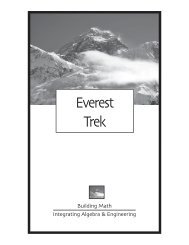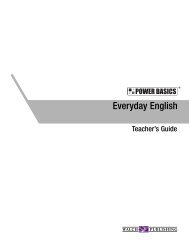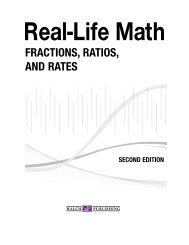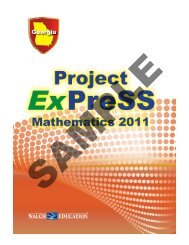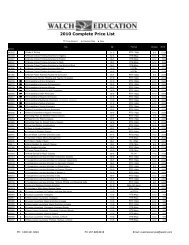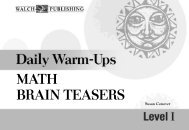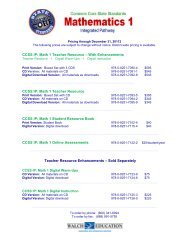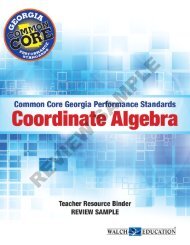Sample Pages - Walch Education
Sample Pages - Walch Education
Sample Pages - Walch Education
- No tags were found...
Create successful ePaper yourself
Turn your PDF publications into a flip-book with our unique Google optimized e-Paper software.
ContentsIntroduction ..................................................................................... vProject Skills Chart ....................................................................... viiGeometry Project Assessment Rubric................................................. viiiProject Putt-Putt................................................................................ 1Ripping Rooms................................................................................. 18Fashionistas....................................................................................... 40At the Scene of the Crime................................................................. 64Protectors of the Realm..................................................................... 95Superhero Challenge........................................................................ 113Thinking Outside the Box.............................................................. 130Director’s View............................................................................... 151This Is Air Traffic Control.............................................................. 168The Great Geometry Race............................................................... 195Expeditions in Your Classroom: Geometry © <strong>Walch</strong> <strong>Education</strong> i iii
Project Skills ChartProjects challenge students to flex more than one mental muscle at a time and integrate skills theyoften see dissected and covered in discrete math book chapters. Each project in this book has acore skill focus, but also gives students an opportunity to practice other skills. Use this chart as areference to help you find the best project for your needs.C = Core skillX = Other skills covered (sometimes optional)ProjectPageMeasurementRatio and proportionScale drawingTriangle and anglemeasurementsPolygonClassifying polygonsmeasurementsCircle geometryThree-dimensionalshapes and visualizationTransformationsCoordinate systemsCalculating slopeGeometric modelingGraph theoryBasic trigonometryProjectPutt-Putt1 X X C C X X X XRippingRooms18 X X C C X C XFashionistas 40 X C X X CAt the Sceneof the CrimeProtectors ofthe RealmSuperheroChallengeThinkingOutsidethe BoxDirector’sViewThis Is AirTraffic ControlThe GreatGeometryRace64 X X C C C95 X X X C C113 X X X X C C130 X X X X X C X151 X X X C C168 X X X X C C195 X X X X X X X X X XExpeditions in Your Classroom: Geometry © <strong>Walch</strong> <strong>Education</strong> vi vii
Geometry Project Assessment RubricPercent ofgrade4 (Excellent) 3 (Good) 2 (Fair) 1 (Poor)Knowledgeand skillsspecific toprojectDefines all key vocabulary, withexamples. Recalls all formulasand methods correctly; canexplain and apply to otherproblems. If required, workshows evidence of researchon topic or theme.Defines majority of terms,with examples. Majority offormulas and methodsapplied correctly. Canapply to other problemswith some incorrectanswers. Shows evidenceof research.Definitions and explanationsare confusing or incorrect.Some formulas are usedcorrectly. Shows littleevidence of research.No knowledge evident.There are few correctmethods and few correctanswers. There is noevidence of research.Measurement/calculationsUses correct formulas. Includesall calculations and diagramsused for solution. Answersare correct.Majority of formulas arecorrect. Most work isshown. There are someincorrect answers.Some formulas are usedcorrectly. Some work is shown.There are a number ofincorrect answers.There are few correctformulas, little work shown,and a small number ofcorrect answers.Drawing andmodelingFinal work meets criteria andexceeds expectations. Allelements are included andcorrectly labeled. Work showsmastery of technique/technicalskill. If required, scale andproportion are representedaccurately.Final work meets criteria.Majority of elements areincluded and labeled. Workshows good command oftechnique/technical skill.If required, scale andproportion are representedaccurately.Final work is missing importantelements. Technique is weak.Scale and proportion are notrepresented accurately.Did not do work/contribute.Did not attempt to learntechnique.Level ofchallengeInvestigated difficult orcomplex situations.Investigated moderatelydifficult situations.Investigated straightforwardsituations.Investigated simplestor easiest situations.Final product Meets all criteria. Organizationand information exceedexpectations. Work reflectsexcellent understanding ofproject content.Meets all criteria.Organization andinformation are presentedclearly. Work reflects goodunderstanding of projectcontent.Meets most criteria. Someelements or componentsare missing.Did not contribute. Didnot submit or is missingmajor components.viiiExpeditions in Your Classroom: Geometry© <strong>Walch</strong> <strong>Education</strong>
Geometry Project Assessment Rubric, continuedPercent ofgrade4 (Excellent) 3 (Good) 2 (Fair) 1 (Poor)Presentation Completed within specific time.Evidence of preparation isobvious. Emphasized mostimportant information. All teammembers were involved.Almost completed withintime. Some preparation isevident. Covers majority ofmain points. Not all teammembers were involved.Almost completed within time.Little preparation is evident.Misses a number of importantpoints. Not all team memberswere involved.Did not participate, did notprepare, was way under orover time, or informationwas confusing anddisjointed.Teamwork Workload was divided andshared equally by all members.Most members, includingstudent, contributed fairshare.Workloads varied considerably.Student did not contribue fairshare.Few members contributed.Student made little to nocontribution.ClassparticipationContributed substantially. Contributed fair share. Contributed some. Contributed very little.Expeditions in Your Classroom: Geometry © <strong>Walch</strong> <strong>Education</strong> ix ix
Project Putt-PuttT eacherpageOverviewStudents design a miniature golf course. They create blueprints and a model for a newchampionship course.TimeTotal time: 6 to 8 hours• Before You Go—Reflection Inspection: 30 to 55 minutes• Before You Go—Uphill and Downhill: 15 minutes• Activity 1—Putt-Putt Blueprints: two to four 55-minute class periods• Concept sketch development: one to two 55-minute class periods• Scale drawings: one to two 55-minute class periods and one to two hours of homework• Activity 2—Mini Model: one to two 55-minute class periods and one to two hoursof homeworkSkill Focus• angles and reflection• slope• two- and three-dimensional modelingPrior Knowledge• measurement• drawing to scale• basic understanding of angles and their propertiesTeam FormationStudents can work individually or in teams of two or three students.Lingo to Learn—Terms to Know• angle of incidence: the angle that a line makes with a line perpendicular to thesurface at the point of incidence• angle of reflection: angle measurement between a reflected ray and a lineperpendicular to the reflecting surface/line at the point of incidence• area: the number of square units needed to cover a surface• congruence: when figures or angles have the same size and shape• isometry: symmetry; a transformation that is a reflection or a composite of reflections(reflections, rotations, translations/slides, and glide reflections are isometries)Expeditions in Your Classroom: Geometry© <strong>Walch</strong> <strong>Education</strong>1
Project Putt-PuttT eacherpage• line of reflection: a line used to create a reflection of a shape (reflecting line or mirror)• perimeter: the sum of the lengths of the sides of a polygon• ratio: a pair of numbers that compares different types of units• reflection: a transformation resulting from a flip• scale drawing: a drawing that is a reduction or an enlargement of the original• slope: the steepness of a line; the measure of change in a surface value over distanceSuggested StepsPreparation• Review the list of materials and collect anything you will provide (a golf ball andmarble for each team, art supplies, and so forth).• Review the Miniature Golf Course Hole Specifications in Activity 1. Adaptspecifications to fit your skill focus. For example, you may wish to make slopedelements optional.Day 11. Provide an overview of the project and review materials.2. Facilitate Before You Go: Reflection Inspection, which addresses angles of reflection.Let students practice and discuss observations. Show how to calculate angles ofincidence and reflection using the tangent function.3. Introduce Before You Go: Uphill and Downhill, an activity on how to determine theslope and angle of slope of an incline.HomeworkIf students have Internet access at home, have them use the Helpful Web Resources to learnabout golf course design and look for examples of miniature golf courses. Encourage them tovisit sites that highlight interesting or famous miniature golf courses.Day 21. Explain Activity 1: Putt-Putt Blueprints.2. Review course holes and drawing specifications. Provide any specific criteria you have(for example, if you do not want students to include slope).3. If this is not an individual project, ask students to select a partner or assign groups.2Expeditions in Your Classroom: Geometry© <strong>Walch</strong> <strong>Education</strong>
Project Putt-PuttT eacherpage4. Provide due dates for assignments (freehand sketches, scale drawings) and/or specifywhether class time will be used.5. Give students a refresher on ratio and scale if needed.6. Allow students to begin brainstorming and planning course hole ideas.HomeworkHave students continue to brainstorm ideas for their course holes and create afreehand sketch.Days 3 through 51. Give students time to work on drawings. Alternatively, if done as homework, askstudents to show signs of progress each day.2. Invite students to describe their ideas, show a first draft or revised sketch, and so forth.3. Check with students to make sure they are on target. Clarify any misconceptions.Design Due Date1. Have students hang design drawings around the classroom.2. Allow 5 to 10 minutes for viewing.3. Solicit observations and feedback. Discuss any design or construction challenges evidentin drawings.4. Explain Activity 2: Mini Model. Review 3-D model criteria. Add other criteriaappropriate to your situation and supplies.5. Assign a due date for models.Model Due Date1. Position course holes on desks around the classroom. Number each hole.2. Give students wooden craft sticks and marbles.3. Let students play a few rounds. You might also have them track scores on improvisedscore cards—notebook paper with three columns for hole number, hole par, and score.Expeditions in Your Classroom: Geometry © <strong>Walch</strong> <strong>Education</strong> 3 3
Project Putt-PuttT eacherpage4. Evaluate the course. Discussion questions might include:• Did anyone get a hole in one?• Which course holes were most challenging and why? Which course holes wereleast challenging?• Does understanding reflection help your game?Final Day1. Have students complete the Skill Check problems.2. Check and review answers.3. Have students complete the Self-Assessment and Reflection worksheet andsubmit it (optional).Project Management Tips and Notes• Review proposed designs. Student course holes tend to get complex! Some studentsmay need redirection to simplify the design. Others may need a gentle reminder thatthe geometry of the course hole and how it plays are more important than appearance.• As written, the project specifies that course holes be as big as a student’s desk and nobigger than two or three desks. You may want to limit designs to one desktop. Thisis great for practical reasons (supplies, space); however, students may find the spacetight for a course hole that should include two bounces and a slope. You can also givea range of dimensions (for instance, larger than 2 feet by 2 feet but smaller than 4 feetby 4 feet). The space doesn’t need to be square.Suggested AssessmentUse the Geometry Project Assessment Rubric or the following point system:Team and class participationTwo scaled hole drawings15 points40 points3-D course hole model 40 pointsProject self-assessment5 points4Expeditions in Your Classroom: Geometry© <strong>Walch</strong> <strong>Education</strong>
Project Putt-PuttT eacherpageExtension Activities• Technologically inclined students may use The Geometer’s Sketchpad(www.dynamicgeometry.com) or other tools to calculate and model angles beforecreating sketches.• Consider having students use a computer-aided design (CAD) program to draft ablueprint or three-dimensional model of their course hole.• Explore other angles involved in golf: a golf swing, golf clubs, the position of courseholes in relation to one another, and so forth.• Ask students to identify and price the materials they need to build their course hole.• As a class, design and build a real miniature golf course. Hold a tournament involvinglocal leaders. Use the event as a fund-raiser. (See Junkyard Golf & Potluck:http://junkyardsports.com/events/golfest.pdf)Common Core State Standards ConnectionHigh SchoolGeometry: Modeling with GeometryG-MG.1. Use geometric shapes, their measures, and their properties to describe objects (e.g.,modeling a tree trunk or a human torso as a cylinder). ★G-MG.3. Apply geometric methods to solve design problems (e.g., designing an objector structure to satisfy physical constraints or minimize cost; working withtypographic grid systems based on ratios). ★Number and Quantity: Quantities ★N-Q.1. Use units as a way to understand problems and to guide the solution of multi-stepproblems; choose and interpret units consistently in formulas; choose and interpretthe scale and the origin in graphs and data displays.N-Q.3. Choose a level of accuracy appropriate to limitations on measurement whenreporting quantities.Grade 8Geometry8.G.2. Understand that a two-dimensional figure is congruent to another if the second can beobtained from the first by a sequence of rotations, reflections, and translations; giventwo congruent figures, describe a sequence that exhibits the congruence between them.Grade 7Geometry7.G.2. Draw (freehand, with ruler and protractor, and with technology) geometric shapeswith given conditions. Focus on constructing triangles from three measures ofExpeditions in Your Classroom: Geometry© <strong>Walch</strong> <strong>Education</strong>5
Project Putt-PuttT eacherpageangles or sides, noticing when the conditions determine a unique triangle, morethan one triangle, or no triangle.7.G.6. Solve real-world and mathematical problems involving area, volume, and surfacearea of two- and three-dimensional objects composed of triangles, quadrilaterals,polygons, cubes, and right prisms.Grade 6Ratios and Proportional Relationships6.RP.3d. Use ratio reasoning to convert measurement units; manipulate and transform unitsappropriately when multiplying or dividing quantities.Answer KeyBefore You Go: Uphill and Downhill1. Slopem = ∆y/∆xm = 9/18m = 1/2 or 50%2. Slopem = ∆y/∆xm = 8/10m = 4/5 or 80%Check Yourself! Skill Check1. Answers will vary.2. 40°A40°50°50°90°B40°40°C100°40°50°6Expeditions in Your Classroom: Geometry© <strong>Walch</strong> <strong>Education</strong>
Project Putt-PuttExpedition OverviewChallengeThe International Pro Miniature Golf Tour is coming to your area. You are a tour championturned course designer and have been asked to construct a unique and challenging course forthe championship event. Tour planners want to see blueprints and a model immediately!Objectives• To explore transformational geometry and learn how to calculate angles of reflection• To calculate slope and angle of slope• To use measurement and geometry skills to create accurate scale drawingsProject ActivitiesBefore You Go• Reflection Inspection• Uphill and DownhillOff You Go• Activity 1: Putt-Putt Blueprints• Activity 2: Mini ModelOther Materials Needed• golf balls• graph paper• paper• colored pencils or crayons• ruler• protractor• cardboard or poster board• other recyclable construction materials (for example, paper towel rolls, containers,box covers, paper cups)• other art supplies (for example, construction paper, felt, water-soluble paint, clay)• scissors• glue• masking tape• marbles• wooden craft sticksExpeditions in Your Classroom: Geometry © <strong>Walch</strong> <strong>Education</strong>7
Project Putt-PuttExpedition OverviewLingo to Learn—Terms to Know• angle of incidence• angle of reflection• area• congruence• isometry• line of reflection• perimeter• ratio• reflection• scale drawing• slopeHelpful Web Resources• History of Miniature Golfwww.terrastories.com/bearings/miniature-golf• IgoUgo—A Field Guide to Mini-Golfwww.igougo.com/story-s1214255-Myrtle_Beach-A_Field_Guide_to_Mini-Golf.html• Professional Miniature Golf Association—Mini Golf Madness on The Travel Channelwww.thepmga.com/Players/News/Mini_Golf_Madness/mini_golf_madness.php• Professional Miniature Golf Association—Miniature Golf, Mathematically Speakingwww.thepmga.com/Players/News/Geometry/geometry.php• RekenWeb Games—KidsKountwww.fi.uu.nl/rekenweb/en/welcome.xml(Click on “Mini Golf” link.)• U.S. ProMiniGolf Association—U.S. Miniature Golf and Mini Golf Courseshttp://prominigolf.com/uscourses.html8Expeditions in Your Classroom: Geometry© <strong>Walch</strong> <strong>Education</strong>
Project Putt-PuttBefore You GoReflection InspectionGoal:Materials:To learn about reflectionone golf ball per group, graph paper, masking tape, pencilsDirections1. Form your group. Gather materials and put the golf ball aside.2. Using graph paper, draw a line 4 to 5 inches long that represents a wall of yourclassroom. Decide how far from the line (wall) you want to position your hole. Markthis point on the graph paper. Label your hole point H. At the bottom of your graphpaper, choose a point that represents your golf ball. Make the distance between thispoint and the line different from that of point H and the line. Label your ball point B.3. Pause for group discussion. Make predictions about the path the ball will take for ahole in one. Take turns sharing how you would visualize the path and mentally gear upfor the shot.4. Draw the path on the grid. Label it “Shot 1.”5. Next, move the hole to a new location. Draw a second path. Label it “Shot 2.”6. Test your predictions. Select a section of wall. Use small pieces of masking tape tomark the ball starting point and your “hole.”7. Experiment with more shots by changing positions of the ball and the hole. If you haveaccess to a space with two walls or solid vertical surfaces, try a few double-bounce oreven triple-bounce shots. Don’t forget to make predictions first.8. Check your reflection prediction skills one more time. Show the path for a one-bounceor two-bounce hole in one below.golf ballholeExpeditions in Your Classroom: Geometry © <strong>Walch</strong> <strong>Education</strong>9
Project Putt-PuttBefore You Go9. What other factors might affect the path of a golf ball on a miniature golf course?Write your ideas below._ ____________________________________________________________________ ____________________________________________________________________ ____________________________________________________________________ ____________________________________________________________________ ____________________________________________________________________ ____________________________________________________________________ ____________________________________________________________________ ____________________________________________________________________ ___________________________________________________________________10Expeditions in Your Classroom: Geometry© <strong>Walch</strong> <strong>Education</strong>
Project Putt-PuttBefore You GoUphill and DownhillGoal: To review how to determine the slope and angle of slope ofan inclineMiniature golf courses often include interesting topography, including sloped or gradedsurfaces such as ramps, steps, or embankments along the sides. How steep such an inclineis can be described by calculating the slope.Slope: m =∆y∆xor “rise over run” given as a ratio or percentageDirectionsDetermine the slope for each diagram below.1.9 mSlope: ______________18 m2.Slope: ______________8" 10" 32"40"Expeditions in Your Classroom: Geometry © <strong>Walch</strong> <strong>Education</strong>11
Project Putt-PuttBefore You GoActivity 1: Putt-Putt BlueprintsGoal: Materials:To create a scale drawing for a miniature golf hole of yourown designcomputer with Internet access, colored pencils or crayons,paper, graph paper, marblesDirections1. Use your Helpful Web Resources and the Internet to learn about miniature golf coursedesign. Be sure to take a look at some of the world’s most interesting and more wellknownminiature golf courses.2. Review the specifications for your miniature golf hole and develop three differenthole ideas. Be creative! For example, choose a theme, a unique location, or interestingtopography for your course hole.Miniature Golf Course Hole Specificationsq The “golf ball” will be a marble.q Players should not be able to sink a ball in one straight shot. Your goal is toprovide a challenge!q The ball must bounce off course sides and/or obstacles at least twice for ahole in one.q The hole must include obstacles, twists, or turns.q The design should use at least three quadrants of graph paper.q Include at least one incline or decline. Vertical drops may also be included.q Challenge: There should be at least two unique shots a player could use to geta hole in one.3. For each of your three ideas, create one freehand aerial view sketch. Show whatyour course hole would look like. Label important elements of the course (tee, hole,obstacles). Add other fun details—the name of the hole, a snack bar, a clubhouse, andso forth.(continued )12Expeditions in Your Classroom: Geometry© <strong>Walch</strong> <strong>Education</strong>
Project Putt-PuttOff You Go4. Review your ideas. Get feedback. Test each concept! For example, use a small ball ormarble and other temporary objects to test possible shots, angles, reflection, level ofdifficulty, and so forth.5. Choose one idea. Create two accurate scale drawings for this idea: an aerial view and across-sectional (side) view. Follow the Scale Drawing Criteria below.Miniature Golf Course Scale Drawing Criteriaq Draw the sketch accurately to scale.q Provide a legend indicating scale.q Use lines exactly where the ball would travel. Tip: Make a photocopy of youraerial view drawing and use the photocopy as a draft until you are sure youhave the paths.q Mark the points the ball must bounce off of for each hole in one.q Provide distance and angle measurements. Include the followingmeasurements:q perimeter of the courseq height of sidesq length and width of the course or course sectionsq location of the tee, hole, and other obstacles relative to sides and othercourse elementsq total surface area of the holeq obstacle dimensions (height, width, clearance, etc. as appropriate)q diameter, circumference, and length of any tunnels includedq slope and angle measurements for course inclinesq height of any vertical dropsq Work is to be neat and colorful. Course elements should be well-labeled (tee,hole, obstacles).General rule: If an item on your course can be measured, provide a measurement. Forexample, if you include a dinosaur obstacle, provide the height, the width at the base, thedistance between the dinosaur’s feet, and the clearance under the obstacle.Expeditions in Your Classroom: Geometry © <strong>Walch</strong> <strong>Education</strong>13




